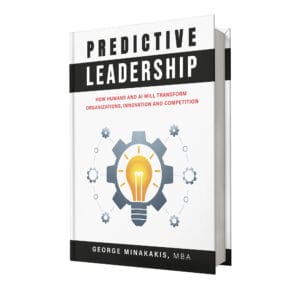

How To Accelerate Organizational Intelligence: Three Core Capabilities of the Future of Work
 Developing an organization’s competitive intelligence is at the core of business survival in the future, especially in this climate where AI, automation, and global trade is being reordered, which is quite the challenge that few are prepared to deal with. Quite simply, no one can continue to compete with 20th-century strategies and tactics, let alone technology, in this 21st century. I made the same argument in 2019 in my book “The Great Transition – The Emergence of Unconventional Leadership.” (Second Edition coming soon)
Developing an organization’s competitive intelligence is at the core of business survival in the future, especially in this climate where AI, automation, and global trade is being reordered, which is quite the challenge that few are prepared to deal with. Quite simply, no one can continue to compete with 20th-century strategies and tactics, let alone technology, in this 21st century. I made the same argument in 2019 in my book “The Great Transition – The Emergence of Unconventional Leadership.” (Second Edition coming soon)
In an age where human and artificial intelligence must operate in harmony, organizations must restructure their workforce around three core capabilities to remain agile, competitive, and innovative. These capabilities define not just what people do, but how intelligence is applied at every level of the enterprise. These three groups of talented workers will be supported by AI. Why, because they have attributes we humans do not. First, they retain a great deal of information. Second, they can recall that information a lot faster. Third, they can process without bias and reasoning capabilities are improving by the day. Basically, this becomes a human’s second brain with the intent to elevate the capabilities of organizational talent and improve, therefore, its intelligence.
“As a reminder, improving an organization’s intelligence begins by industrializing human and artificial intelligence to work together, identifying, developing, and delivering the next generation of strategies and innovations for an organization to remain relevant and competitive.”
So what are the key groups of workers?
1. Creators
Purpose: The creator’s role is to continue the creation of trends defined by an organization’s imagination, originality, designs, and innovations that they can produce to build their business continuity.
These individuals generate original ideas, envision new opportunities, and build future pathways. The outcomes expected from workers in these roles include creating new concepts, developing business models, and redefining consumer experiences, mainly as AI assistants, and the walls they operate within proliferate.
2. Solvers
Purpose: To analyze, diagnose, and develop solutions.
Solvers are your organization’s intelligence engine. They use critical thinking, analytics, and machine learning models to turn complexity into clarity. With AI at their side, they identify risks, optimize systems, and create actionable insights from data. They are the analysts, data scientists, systems architects, strategists, and consultants. They may use predictive models, digital twins, and decision intelligence platforms. And will optimize strategies and operational efficiency and mitigate risks.
3. Executors
Purpose: They will work with creators and solvers to effectively and efficiently deliver products and services to market and ensure that there is collaboration and consistency throughout every aspect of the organization. Executors bring ideas and solutions to life. They may lead implementation, scale operations, and ensure reliability. Utilizing the support of AI-driven automation and robotics, their productivity and accuracy increase while human focus shifts to oversight and continuous improvement. Those who are engaged in these roles are project managers, operations teams, sales, customer service, and logistics teams.
Why This Shift Matters
We are all going to be using AI and Automation to some degree in the workplace, and as organizations strive to elevate their intelligence, they will be restructuring the organization.
This new structure moves away from traditional hierarchical functions and embraces a fluid, intelligence-based model. It allows organizations to:
• Align human and AI intelligence based on purpose and capability.
• Reskill teams around core competencies of innovation, analysis, and execution.
• Respond faster to disruption by allocating the right intelligence to the right challenge.
The time to act is now, as larger, more capable organizations reach AI escape velocity in their competitive skill sets. Everyone will once again be chasing the leaders. That’s not the best competitive position to be in. How to accelerate organizational intelligence? That also depends on the organizational culture and leadership.
George Minakakis is the CEO of Inception Retail Group Inc. He is the author of four books, the most recent Predictive Leadership – How Humans and AI Will Transform Organizations, Innovation and Competition. He is also a former Country Manager and CEO, having worked with Pepsico and Luxottica. 
CEO | MBA | Author | Advisor | Speaker | Business Visionary
George Minakakis is a Thought Leader and Keynote Speaker. His experience leading, developing, and reviving global brands make him a sought-after Executive Advisor.